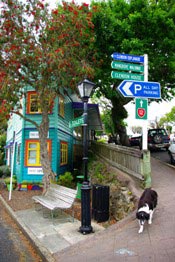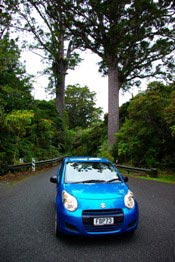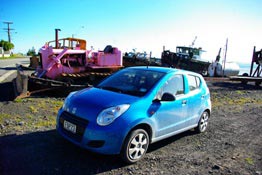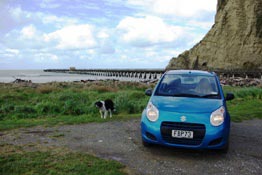Read more of Allan's blog entries by clicking here.
After several delays, I finally roared out of Auckland around 12:30 on a Wednesday afternoon and sneaked back in at 8:15 the following Monday evening. I’d had five and a half days on the road, covered 4,500km and had the time of my life.

CAPTION: Rawene in the Far North is quaint and picturesque — Kate checks out the talent
In the past decade I’ve completed three, or is it four, Laps of the South Island which is a comparatively easy thing to do if you accept that the term “Lap” takes you as close to the coast as you can all the way. With the exception of Fiordland and the Kahurangi National Park, there are civilised roads almost all the way around the coast of the South Island. Not so the North and I was prepared for detours and plenty of long and winding roads. I wasn’t disappointed!
Normally it’s the navigator who sits alongside me on these trips, but she had grandmother duty in Christchurch so it was Kate the Editorial (Border Collie) Assistant who came along on this drive.
The route took me from Auckland around the huge Kaipara Harbour to Dargaville where I stayed the night. Next morning it was up the West Coast, through the Waipuoa Forest, across the Hokianga, up through Broadwood to Ahipara and on to Awanui. Here I bade adieu to the West Coast for a while and headed across to Coopers Beach and threaded my way down through the holiday towns to Whangarei where I overnighted.

CAPTION: The big Kauri in the Waoipuoa Forest are known as Darby and Joan
Next morning I cheated for the first time. Early on I had decided against making the side trip to Cape Reinga because, unless I used 90 Mile Beach, it was a case of there and back on the same road. But, from Whangarei to Auckland I used SH1 instead of tiki-touring from Waipu, down through Mangawhai to Warkworth sticking with the coast. I’ve done that trip countless times and, besides, the weather was most foul. Squally rain, gusty winds — but worse was to come.
The rest of the day was spent in driving rain and near gale force winds as our inclement spring weather continued.
Up the Coromandel Coast, across to Whitianga and on south there was just no letup. Rain, rain and more rain.
I made it as far south that night as Whakatane after one of the worst drives I’ve had in a long time. It was like driving along the bottom of a lake.
I had stopped in Te Puke for fish and chips (and a quarter loaf of Maori “Rewa” bread which I brought home with me and use for “toasted cheese”) and got into brief conversation with two back-packers waiting patiently outside the fish and chip shop for the rain to ease. One was from Argentina, the other from Uruguay. I felt sorry for them. I apologised for both the weather and my inability to give them a ride, as their packs were just too big to get everything into the Suzuki Alto.
They smiled, shrugged their shoulders, said thanks anyway and continued being cheery. I’m not sure I would have been.
Next morning the rain had more-or-less stopped, but the winds were still up and the drive around the East Cape was sensational as the waves pounded up onto the beaches.
I had filled up with juice at Whakatane, but when I reached Te Araroa I felt I might not get to Gisborne without some more petrol and at the rate that service stations are closing, I pumped $20 worth in just to be sure.
Here I met Doug, a local, who told me why it is that you find green eyes and red hair in the people of the Ngati Porou.
There have been all sorts of conspiracy theories over this — there were fair skinned, red-headed, green eyed people there before Maori who conquered them, ate most of them, but bred with the survivors being the favourite. But it’s all thanks to genes and good old Manuel Jose.
Manuel was a Spaniard who arrived with his small whaling vessel on the coast from Ruatoria in 1835. He quickly gave up whaling and set up a local shop and ended up marrying five local Maori women. He was prolific and so were his offspring. Today it’s estimated there are 16,000 descendants of Manuel Jose called Paniora.
They are proud of their Spanish connections on that part of the coast.
It was getting dark by the time I rolled into Gisborne, after doing all of the usual stops along the way, but I decided to press on through the gloom to Napier.
The day had been patchy — strong winds and frequent squally showers, but nothing like the day before. But rivers were up and there were minor slips everywhere. Forty kilometres out of Napier the gloom of the night was split by the red and blue flashing lights of police cars. I slowed — there was a police car on either side of the lonely road — but was waved through. There’d been a sizeable slip here that had partially blocked the road.
Next day was a long one.
From Waipukerau I headed for the coast through the legendary Hawkes Bay hill country, finally emerging at Masterton.
This is remote, rugged and lonely.
I made a detour out to Blackhead, passed the place with the longest name in the world, had a pie in Pongaroa and stopped to have a chat to a man who was part of a team eliminating rooks in the area. This was just one of several remarkable stories I heard on the road, but there’s not the space here to go into detail.
At Masterton the Navigator phoned to tell me I had an appointment in Auckland on Tuesday morning that I couldn’t miss — and it was late Sunday afternoon already and I was barely 50% of my way through the journey!
So it was hammer down time.
I had to make a decision — was it out to Castle Point, or on to Ngawi out at Cape Palliser on the far flung South East corner of the North Island, home to most on New Zealand’s old bulldozers? They are used for launching and retrieving boats off the steep shingle beaches. I chose the latter even though it was a case of there and back on the same road.
At Ngawi the seas again were spectacular — and just a bit scary.

CAPTION: The Suzuki Alto contrasts with the famous bulldozers of Ngawi
Kate and I both said hello to the seals and then headed for Wellington and a quick cup of coffee with friends before making it as far as Levin that night.
It had been a long day, but the next day, the final one, would be just as long.
From Levin it was straight up SDH1 through Wanganui , Hawera and out around Cape Egmont.
Into New Plymouth and up the coast, stopping for a yarn with whitebaiters at Awakino before heading up the remote road to Waitomo Caves via Marakopa — and Waikawau Beach where access is via a tunnel dug in 1911 so that cattle could be driven along the beach from Newton King’s huge station.
This is a place I’d heard of, but really has no idea where it was. This is the second “tunnel” beach I know of in New Zealand. The better known is the one down through the cliffs at St Clair near Dunedin. Are there any others?
I had a reviving cup of coffee at Waitomo Caves and then headed off onto the home stretch.
I admit that I finished feeling a little unsatisfied — I really needed another four or five days to see everything I wanted to see. But I arrived home with plenty of impressions — the most lasting being the vast differences in living standards I came across. You don’t get this in the South Island.

CAPTION: Some restoration work is underway on the old wharf at Tolaga Bay. Kate continues to sniff out the local talent
In Northland and around the East Cape road in particular there are people living in what many of us what call squalor, or poverty. But that is to devalue these words because there is no need for people to live this way in New Zealand. If they want to live in hovels with rotting wood, broken windows patched with black plastic rubbish bags, surrounded by the “graveyards of rusting automobiles”, to quote Arlo Guthrie, that is their choice.
But perhaps the most depressing sight of all was the disgusting condition of the old hospital in Waipukerau. There’s a flash new one up the road, but the old complex has become a major health and safety issue and I am surprised nothing’s been done about it.
Apart from that, it was a fabulous trip. I ate on the run and slept in the most inexpensive motels I could — price ranged from $75 a night to $100.
Once again, I was mightily impressed with the Suzuki Alto. Fuel economy wasn’t quite was it was on the Auckland to Bluff and return trip, but I averaged 62 miles to the gallon for the trip (about 4.4L/100km) which was very impressive considering I really had to press on a bit through some very demanding landscape.
But the aspects that really stood out were how capable the car was on the road and how comfortable it was. I was spending 12 or 13 hours a day driving and each night I emerged from the car without any aches, pains or cramps.
This was a different experience altogether to the Laps of the South Island I’ve done. There’s not the overwhelmingly spectacular scenery there is in the South — no Milford Sound — but it’s still a very special place.
The full story of this trip will appear in the next issue of NZ TODAY, out at the end of November.









Aggie - 14 years ago
An wonderful article Allan, I could almost be tempted by one of those Suzuki Alto’s. The shape of them is much improved. Obviously very good comfort-wise too for as I recall you have back problems.